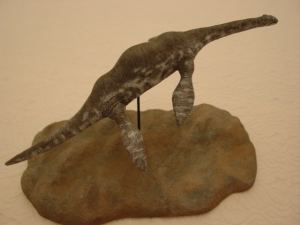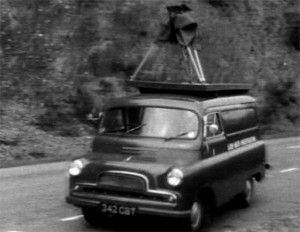First Nessie Sighting of 2012?
Posted by: Loren Coleman on April 5th, 2012

Gary Campbell reports this from Loch Ness:
A local man travelling south on the A82 road at 5:15pm on Wednesday 4th April [2012] reported seeing a circular whirlpool like disturbance on the otherwise flat calm loch. The disturbance was near the middle of the loch just south of Urquhart Castle. He said it was similar to the disturbance that is caused at sea by bait fish being forced to the surface by larger predators. There was no boat traffic in the area at all.

Will this be a good year for new Lake Monster encounters?
About Loren Coleman
Loren Coleman is one of the world’s leading cryptozoologists, some say “the” leading living cryptozoologist. Certainly, he is acknowledged as the current living American researcher and writer who has most popularized cryptozoology in the late 20th and early 21st centuries.
Starting his fieldwork and investigations in 1960, after traveling and trekking extensively in pursuit of cryptozoological mysteries, Coleman began writing to share his experiences in 1969. An honorary member of Ivan T. Sanderson’s Society for the Investigation of the Unexplained in the 1970s, Coleman has been bestowed with similar honorary memberships of the North Idaho College Cryptozoology Club in 1983, and in subsequent years, that of the British Columbia Scientific Cryptozoology Club, CryptoSafari International, and other international organizations. He was also a Life Member and Benefactor of the International Society of Cryptozoology (now-defunct).
Loren Coleman’s daily blog, as a member of the Cryptomundo Team, served as an ongoing avenue of communication for the ever-growing body of cryptozoo news from 2005 through 2013. He returned as an infrequent contributor beginning Halloween week of 2015.
Coleman is the founder in 2003, and current director of the International Cryptozoology Museum in Portland, Maine.










Nessie was the first cryptid I “discovered”. It was in grade school in the school library. From there I read all three books they had covering the topic, then all the books at the local city library.
I don’t know what Nessie is, or even if there is anything that large that lives in the loch, but I have spent many hours wondering what it would be like if Nessie really was down there.
Must be one of Roy Mackal’s amphibians, the Giant Embolomer.
A “circular whirlpool-like disturbance?” That’s it? What next, a “suspicious ripple?” A “strange wave?” An “unearthly splashing?”
If this were any other body of water on Earth, nobody would think twice about it. But since there’s an alleged monster there, every stray bubble and patch of foam is suddenly significant. This doesn’t even qualify as bad evidence.
@ Genus Unknown – While I agree that a whirlpool on it’s own is not significant evidence, it is in my opinion worth mentioning because it promotes the idea of people watching the water for abnormalities along the surface. Not that Loch Ness needs much help in that department, but more sightings – even insignificant false positives – means more attention on the water. Whirlpools can easily be explained way, so there is no harm in mentioning it on a sight dedicated to this discipline.
It’s the hoaxing that does the most harm, not the over-enthusiastic masses calling every ripple a lake monster and every black bear a bigfoot.
Yeah, there’s enough wave activity going on in the loch that seiche waves could create such things as well. The whirlpool of bait fish coming to the surface is an interesting theory, but certainly not conclusive here.
As for 2012 and water cryptids? I think we’ll have some sightings and incidents. Maybe we’ll get some other things caught on camera or in nets in the oceans now that the giant squid has been confirmed. More eyes in the water means more chances to find new species. I’ll hazard a guess and say there at least a half dozen new water species discovered with some size to them…I’ll leave one space open for a caddy or its kin…
@ Novelhawk
@ Genus Unknown
I’m not sure gentlemen; on one hand, we have enthusiasm, which could potentially prevent “the search” from ending. But will that really become a problem? The Loch has already gained such a reputation, that I doubt it will ever be seen as anything besides a murky dwelling for ‘something’. With that, I’m sure we’ll have Nessie hunters for as long as it takes for something to be found.
On the other hand, it is, after all, confirmation bias on overdrive. It’s absolutely true, any other body of water wouldn’t warrant an after thought; ripples, waves and bubbles do, ‘just happen’. However, we can’t dismiss the possibility that there may be more to it, lest we lose an opportunity to discover something truly fascinating.
I personally lean more with Genus Unknown, in that hype over what is probably nothing adds to a negative stigma surrounding the field. However, ripples and enthusiasm keeps this stuff alive, and I feel there is a lot here that needs real attention (the field, not necessarily this case/sighting). Maybe if they looked further than just this, and brought attention to whatever it may have led to.
I don’t know what’s in store for the Loch Ness Monster this year, but I’m going to tell you straight up that there will be quite a bit more attention directed to the Thetis Lake Monster this summer.
“Will this be a good year for new Lake Monster encounters?”
– If you set the bar this low, yes.
springheeledjack wrote “Yeah, there’s enough wave activity going on in the loch that seiche waves could create such things as well.”
But isn’t thermal stratification the first requirement for an internal seiche, and isn’t Loch Ness well mixed in April? And do seiches ever create visible effects on the surface? I would be interested in reading any evidence that they do.
I agree with Genus Unknown, on this one. “A strange, whirlpool-like disturbance” is simply not enough evidence, for me to come to any conclusions, at all. It could be anything. I’d say it is probably a shoal of fish, at the surface. However, let’s use Occam’s Razor, here; Would it be more likely to say that this shoal of fish was being chased by a large unknown predator, or did they just happen to swim close to the surface? Personally, I feel that the latter option is far more likely.
In my opinion, Nessie does exist. However, if cryptozoologists, like us, want to convince mainstream scientists that our field of inquiry is not a “pseudoscience”, then, we had obviously better try much harder, than this!